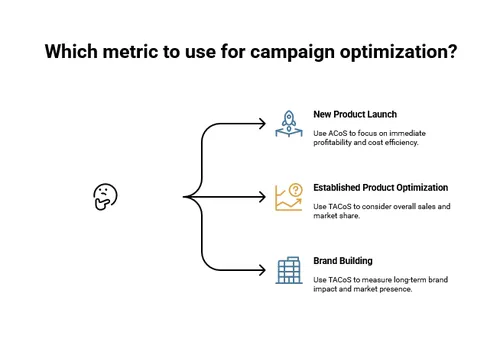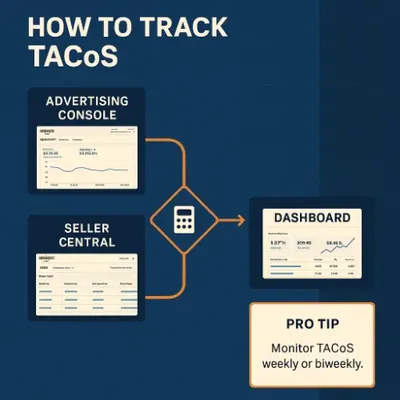
ACoS vs TACoS: The Ultimate Guide to Choosing the Right Amazon Advertising Metric
Table of Contents
When evaluating your Amazon PPC performance, choosing between ACoS and TACoS can make the difference between misleading metrics and genuine business growth. Both metrics offer valuable insights, but they serve fundamentally different purposes in your advertising strategy. I’ll help you to determine which metric better serves your specific business goals, campaign types, and product lifecycle stages.
What you’ll discover: A clear decision framework for when to prioritize ACoS vs TACoS, industry-specific benchmarks, practical implementation strategies, and advanced optimisation techniques that go beyond basic metrics understanding.
Part 1: Understanding the Basics
What is ACoS?
ACoS (Advertising Cost of Sales) measures the percentage of sales spent on advertising. It’s calculated as:
ACoS = (Ad Spend ÷ Ad Sales) × 100%
For example, if you spend £100 on ads and generate £400 in ad-attributed sales, your ACoS is 25%.
What is TACoS?
TACoS (Total Advertising Cost of Sales) measures ad spend as a percentage of total sales (both organic and paid). It’s calculated as:
TACoS = (Ad Spend ÷ Total Sales) × 100%
Using the same £100 ad spend, if your total sales (including organic) are £800, your TACoS is 12.5%.
The Key Differences
| Aspect | ACoS | TACoS |
|---|---|---|
| What it measures | Ad spend vs. ad-attributed sales | Ad spend vs. total sales (organic + paid) |
| Available in Amazon | Yes, directly in dashboard | No, requires manual calculation |
| Best for measuring | Campaign-level efficiency | Overall business impact of advertising |
| Sensitive to | Click-through rate, conversion rate | Brand awareness, organic ranking improvements |
| Blind spots | Ignores organic sales lift from ads | Can be skewed by strong organic performance |
| Primary use case | Optimizing ad campaigns | Evaluating advertising’s impact on total business |
The key distinction: ACoS is campaign-focused, while TACoS is business-focused.
ACoS answers: “How efficiently are my ad campaigns generating direct sales?”
TACoS answers: “How are my advertising investments affecting my overall business performance?”
Part 2: When to Use Each Metric
The ACoS-TACoS Decision Framework
Choosing the right metric depends on your specific situation. Here’s a practical framework to guide your decision:

When ACoS is the Better Metric
ACoS should be your primary focus when:
1. Launching New Products During the initial launch phase, you’re primarily concerned with generating those first sales and reviews. Organic visibility is minimal, making direct ad performance crucial.
2. Optimizing Campaign-Level Performance When fine-tuning individual campaigns, ad groups, or keywords, ACoS provides the granular feedback needed to make tactical adjustments.
3. Managing Short-Term Profitability If cash flow is tight and you need to ensure immediate profitability on ad spend, ACoS gives you the direct insight into campaign-level ROI.
4. Conducting Keyword-Level Analysis ACoS helps identify which specific keywords are converting efficiently, allowing you to allocate budget more effectively.
When TACoS is the Better Metric
TACoS becomes more valuable when:
1. Evaluating Brand Building Efforts If you’re investing in brand awareness campaigns, the benefits often appear as increased organic sales rather than direct ad attributions.
2. Measuring Long-Term Business Health TACoS provides a more holistic view of how your advertising contributes to overall business growth over time.
3. Assessing Mature Product Performance For established products with strong organic rankings, TACoS better reflects the true impact of your advertising investment.
4. Making Strategic Budget Decisions When deciding overall advertising budgets, TACoS provides insight into how advertising affects your entire business performance.
Part 3: Industry Benchmarks and Target Setting
Realistic Target Ranges by Category
| Category | Target ACoS Range | Target TACoS Range | Notes |
|---|---|---|---|
| High-margin electronics | 15-25% | 5-10% | Higher price points allow for more aggressive advertising |
| Low-margin consumables | 10-15% | 3-7% | Thin margins require tighter ad control |
| Luxury/premium items | 25-40% | 8-15% | Higher margins support brand-building investment |
| Seasonal products | 30-50% (in season) 10-20% (off season) | 10-20% (in season) 5-10% (off season) | Requires adaptive targets based on seasonality |
| New product launches | 40-70% | 30-50% | Initial investment period to gain traction |
Setting Your Own Targets
Rather than relying solely on industry averages, calculate your specific targets based on:
For ACoS:
- Your profit margin minus desired profit
- Break-even ACoS = (Revenue - COGS - Amazon fees) ÷ Revenue
For TACoS:
- Your overall business profit margin
- Consider the long-term value of customer acquisition
Part 4: Practical Implementation
Tracking and Measurement Systems
1. Amazon Advertising Console Limitations The native console only provides ACoS data. To calculate TACoS, you’ll need to combine data from multiple sources.
2. Manual TACoS Calculation Process At minimum, follow these steps:
- Export your Advertising reports from Amazon Advertising Console
- Export your Business reports from Seller Central
- Combine the data in a spreadsheet
- Calculate TACoS using the formula: (Ad Spend ÷ Total Sales) × 100%

Case Studies: ACoS and TACoS in Action
Case Study 1: New Product Launch A kitchen gadget manufacturer launched a new garlic press with these results:
| Month | Ad Spend | Ad Sales | Total Sales | ACoS | TACoS |
|---|---|---|---|---|---|
| 1 | £2,000 | £3,000 | £3,200 | 67% | 63% |
| 2 | £2,500 | £5,000 | £6,000 | 50% | 42% |
| 3 | £3,000 | £8,000 | £12,000 | 38% | 25% |
Analysis: Initially, both ACoS and TACoS were high as expected for a new product. By month 3, the significant gap between ACoS (38%) and TACoS (25%) revealed that advertising was successfully generating organic sales through improved rankings and reviews.
Strategy: For new products, focus primarily on ACoS for the first month, then begin tracking TACoS from month 2 onwards to measure the flywheel effect.
Part 5: Advanced Optimization Strategies
The Balanced Approach
Most successful Amazon sellers use both metrics strategically:
1. Dual-Metric Dashboards Create reporting systems that track both ACoS and TACoS simultaneously, with different review frequencies:
- ACoS: Weekly reviews for tactical adjustments
- TACoS: Monthly reviews for strategic decisions
2. Weighted Performance Indicators Create a combined score based on your business priorities:
- Growth phase: 30% ACoS weight, 70% TACoS weight
- Profit phase: 70% ACoS weight, 30% TACoS weight
3. Seasonal Adjustment Tactics Adjust your focus seasonally:
- Peak season: Prioritize ACoS to maximize direct returns during high-volume periods
- Off-peak: Shift focus to TACoS to build organic momentum for the next peak
Integration with Other Key Metrics
To gain a complete picture, integrate ACoS and TACoS with these complementary metrics:
1. CTR and Conversion Rate Correlation
- Low CTR + High ACoS = Ad creative problem
- High CTR + High ACoS = Listing conversion problem
- Monitor how improvements in these metrics affect your TACoS over time
2. Impression Share Impact
- Track how your impression share correlates with TACoS
- Increasing impression share often improves TACoS even if ACoS remains constant
3. New-to-Brand Metrics Alignment
- High New-to-Brand percentage + High ACoS = Acceptable for customer acquisition
- Monitor how New-to-Brand customers affect TACoS over 60-90 day periods
4. RoAS and Profit Margin Integration Create a unified dashboard that includes:
- ACoS (campaign efficiency)
- TACoS (business impact)
- RoAS (return on ad spend)
- Net profit margin (bottom-line impact)
This integrated approach provides a comprehensive view of advertising performance.
Conclusion: Making the Right Choice
The ACoS vs TACoS debate isn’t about choosing one over the other—it’s about understanding when each metric provides the most valuable insights for your specific situation.
ACoS excels at:
- Campaign-level optimisation
- Short-term profitability assessment
- New product launch evaluation
- Keyword-level performance analysis
TACoS excels at:
- Overall business health assessment
- Long-term growth measurement
- Brand building evaluation
- Mature product advertising strategy
The most successful Amazon sellers use both metrics in harmony, shifting focus based on their current business objectives, product lifecycle stage, and competitive landscape.
Start by establishing reliable tracking for both metrics, set appropriate benchmarks for your specific business, and develop a rhythm of reviewing each metric at the appropriate intervals. With this balanced approach, you’ll make more informed advertising decisions that drive both immediate returns and long-term business growth.